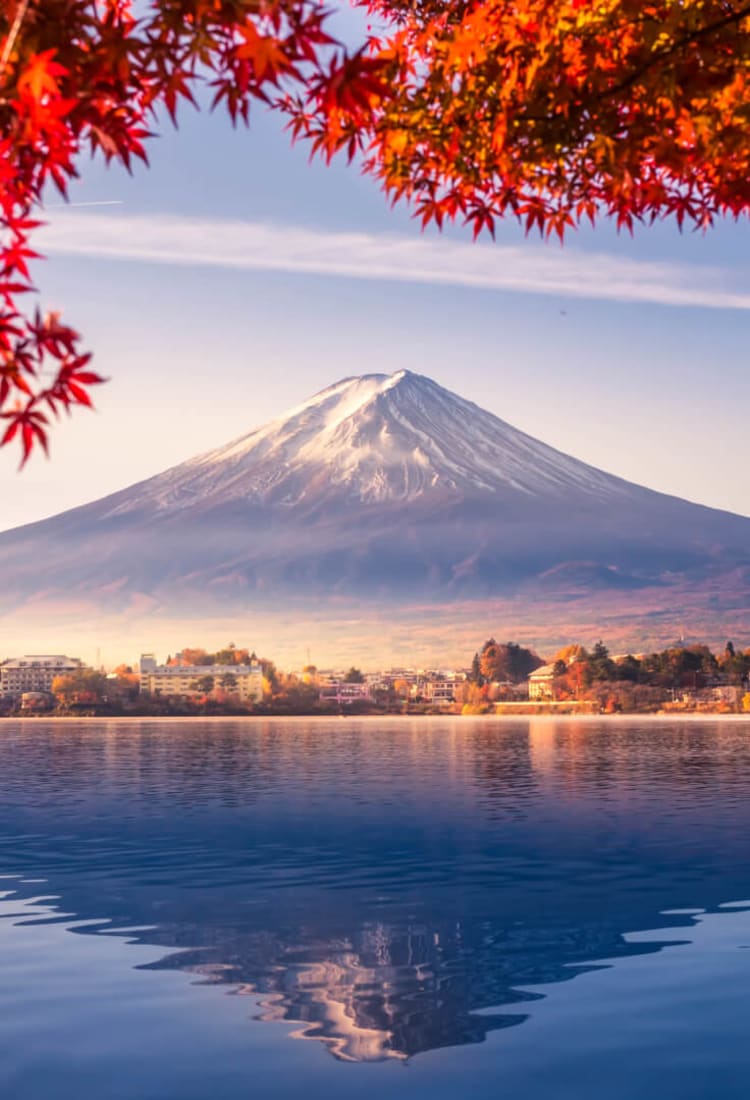
STORY 9 spectacular places to see autumn leaves in Japan
Discover the Japanese tradition of momiji-gari and the best places to see koyo!
Autumn is the time of year when things slow down, the days get shorter and the temperature drops. It’s a time for getting cosy. But in Japan, it’s also a great time to get outdoors! Over two-thirds of Japan is covered by forests, much of which is made up of deciduous trees, meaning that traditional gardens, national parks, gorges and mountainsides turn vibrant with autumn colours.
The Japanese tradition of autumn leaf viewing has been a pastime since the eighth century and is called momiji-gari in Japanese (maple leaf hunting). Autumn colours, known as koyo, can be seen from late September through to early December, depending on the location. Maples display deep reds, ginkgo trees turn golden yellow, and Japanese rowan and larch offer bright oranges and yellows.
Here are 9 spectacular spots where you can see koyo and experience the popular Japanese pastime of momiji-gari.
1. Daisetsuzan National Park
Hokkaido Prefecture

Matsumi Bridge in Mikuni Pass - Image: Chen Min Chun/Shutterstock.com
Located in the heart of Hokkaido, Daisetsuzan is Japan’s largest national park. The park environments include marshlands, mountains and an alpine belt. Due to the large area and varying habitat, a wide range of flora and fauna thrive here.
Daisetsuzan National Park displays some of the earliest autumn leaves in Japan. Visit from early September until the beginning of October to view the changing colours of the thick forests. A hike is one of the best ways to see the vibrant foliage. Climb Mt Asahidake, Mt Tomuraushi or Mt Tokachidake for sweeping views across the countryside.
Sit back, relax and cruise over the top of the trees as you ascend Mt Kurodake on the Kurodake Ropeway (cable car). Catch the ropeway from the Sounkyo Visitor Center.
2. Tateyama Kurobe Alpine Route
Nagano and Toyama Prefectures
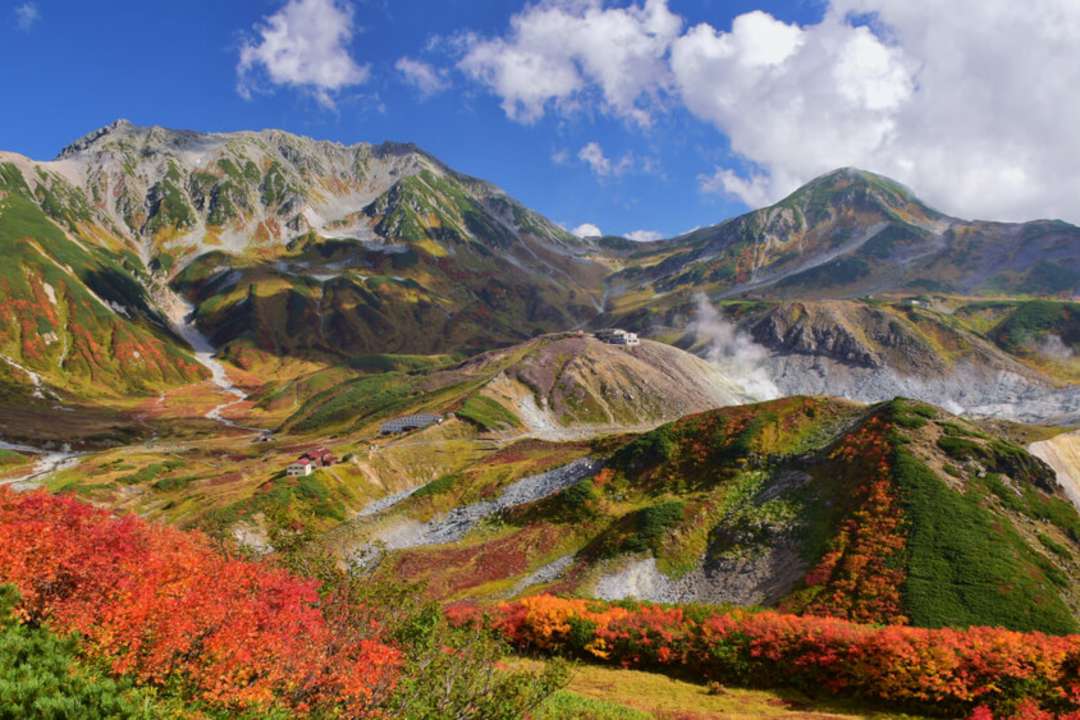
Autumn leaves in Tateyama. Image: Sadao/Shutterstock.com
Spend some time in Japan's Northern Alps, otherwise known as ‘the roof of Japan’. The Tateyama Kurobe Alpine Route connects Nagano and Toyama Prefectures. Open from mid-April until the end of November, this is a fantastic place to admire the changing seasons.
The autumn colours appear in stages due to the changing altitudes. The peak is usually in October at higher altitudes and November for the lower areas. Taking the Tateyama Ropeway is also a great way to view the vibrant vistas, passing by the reservoir and surrounding mountains along the way. The highest point along the route is known as Murodo. Stop here if you’re looking to go for a hike or stay a night at Japan's highest altitude hotel, Hotel Tateyama.
3. Lake Kawaguchi
Yamanashi Prefecture
![]()
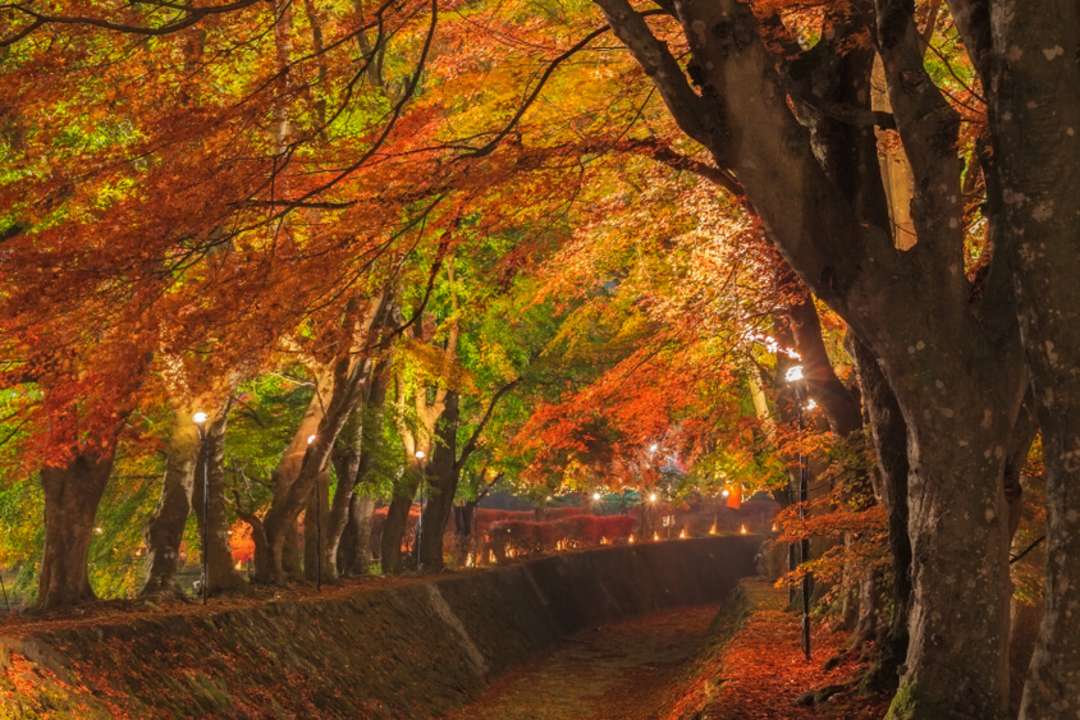
The Momiji Tunnel on the Nashigawa River in Japan. Image: Anujak Jaimook/Shutterstock.com
With easy access from Tokyo and stunning views of Mt Fuji, Lake Kawaguchi is a popular destination. Autumn provides a fantastic photo opportunity with Mt Fuji framed by fiery red maple leaves. If you’re visiting in November, attend the Fuji-Kawaguchiko Autumn Leaves Festival located on the northern shore of the lake.
The lake is also a hive of recreational activity where you can rent a bike, take a boat cruise, windsurf, camp, fish and more! Wind down after a day of activity at one of the hot spring hotels. Bathing with a view of Mt Fuji and a landscape of bright scarlet and oranges… pure bliss!
4. Irohazaka Winding Road
Tochigi Prefecture
![]()

Aerial view of Irohazaka Winding Road. Image: LightRecords/Shutterstock.com
The ultimate scenic road trip! Irohazaka Winding Road has a total of 48 bends and is named after the 48 syllables of the Japanese alphabet (kana). The route connects the city of Nikko with Lake Chuzenji and the trees in the surrounding forest offers a spectacular array of autumn colours. Take the Akechidaira Ropeway and stop at Akechidaira Observation Deck on the way down for one of the best views.
After all that zig-zagging, take a break at Kegon Falls. Feel re-energised amongst the red and yellow leaves and absorb the negative ions as the water plunges 97 metres onto the rocks below.
5. Icho Namiki Avenue
Tokyo Prefecture
![]()
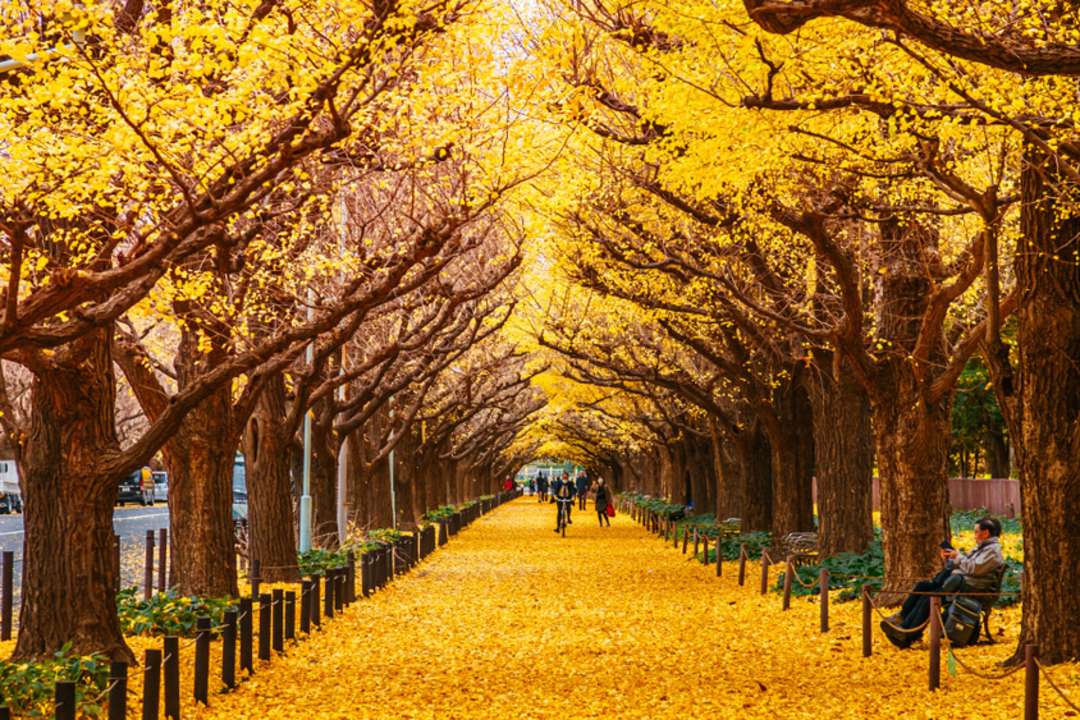
A tunnel of yellow ginkgo trees at Jingu Gaien Icho Namiki Avenue. Image: PixHound/Shutterstock.com
Take a stroll down a road of golden trees in Tokyo. Icho Namiki means ‘a row of ginkgo trees’ and is best visited in late November and December if you want to catch it in full autumn splendour. As you reach the end of the avenue you’ll find Meiji Jingu Gaien, a sports and history complex. Here you can go ice-skating, attend the golf range or watch a game of pro-league baseball (March-October).
Icho Namiki Avenue is easily accessible via public transport and is just a few minutes’ walk from Aoyama-itchome Station.
6. Kenrokuen Garden
Ishikawa Prefecture

Japanese Garden at Kenrokuen Garden, Kanazawa City, Ishikawa Pref., Japan. Image: Amstk/Shutterstock.com
Kenrokuen Garden is a beautiful location with fragrant flowers, winding paths, peaceful ponds and tranquil teahouses. The name Kenrokuen means ‘garden that combines six characteristics’. These are: spaciousness, seclusion, artifice, antiquity, water sources and magnificent views. It is a must-see no matter the season. In autumn the Japanese maple leaves turn scarlet and create a cosy atmosphere. The garden is also located right next to the famous Kanazawa Castle.
7. Naruko Gorge
Miyagi Prefecture
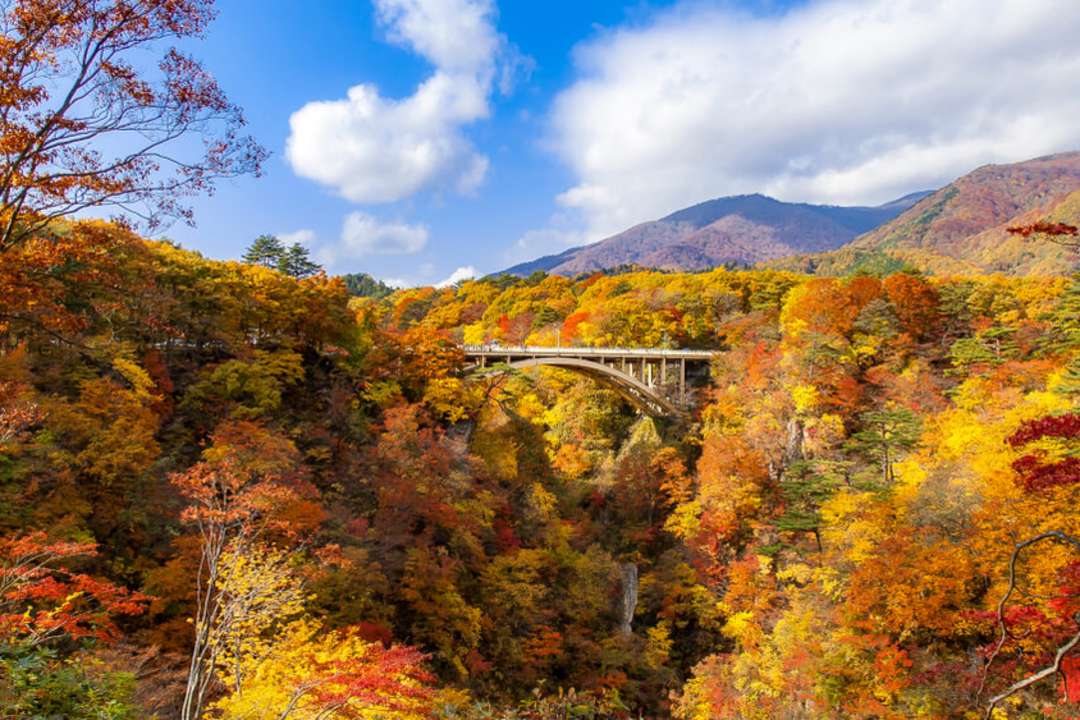
View of the bridge across Naruko Gorge near Sendai in Miyagi, Japan. Image: Kapi Ng/Shutterstock.com
Kurikoma Quasi-National Park is officially recognised as a place of scenic beauty. Visit Naruko Gorge from mid-October to early November to find a beautiful array of reds, oranges and yellows covering the landscape. The best viewing opportunities are in the valley, on the bridge or at the observation platform. Start your koyo journey at the Narukokyo Resthouse and then make your way to the viewing platform to see the photogenic Ofukazawa Bridge.
8. Koyasan
Wakayama Prefecture
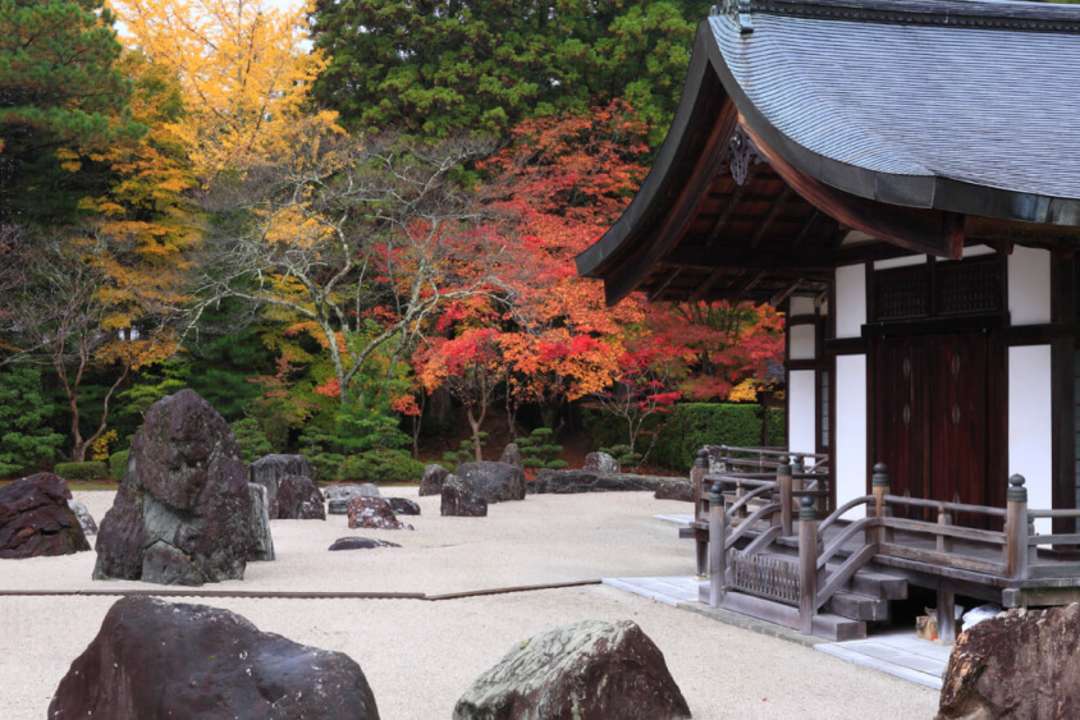
Stone garden (Kongobuji Temple) © Wakayama Prefecture.
High up in the forested mountains of Wakayama Prefecture sits Koyasan, a large complex dedicated to Buddhism. Historically, it was a welcome sight for travellers walking the Kumano Kodo pilgrimage route as it signified the end of their journey.
Koyasan is a UNESCO World Heritage site with over 100 temples to explore, 52 of which also offer ‘shukubo’ temple lodgings. Whilst it is well known for its culture, history and tradition, it is lesser known as a koyo location. A visit from October to early November is the best time to see the forest ablaze with the colours of autumn.
9. Kuju Mountains
Oita Prefecture
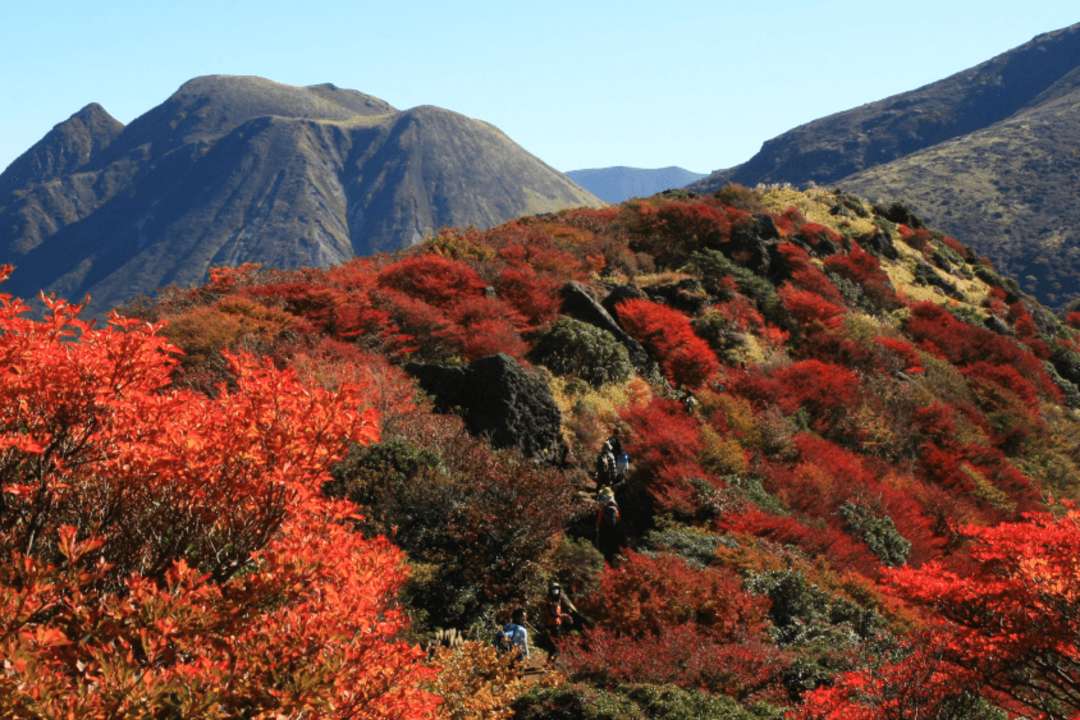
Kuju Mountains, Oita Prefecture.
The Kuju Mountains are a part of the Aso-Kuju National Park. There are so many options to explore the park including by foot, car, horseback, helicopter or even hot-air balloon.
Visit the park in October and November to witness the forests at the base of the mountains blushing with warm colours. Make sure to visit Kokonoe Yume Otsuribashi which offers a spectacular vantage point.
There are plenty of hiking trails with an option to circle all of the main peaks in around six hours. Due to the volcanic activity in the area, there are plenty of bathing onsen to warm up on those cooler nights. For something unique head to Nagayu Onsen, a hot spring resort area known for its naturally carbonated baths!



















































